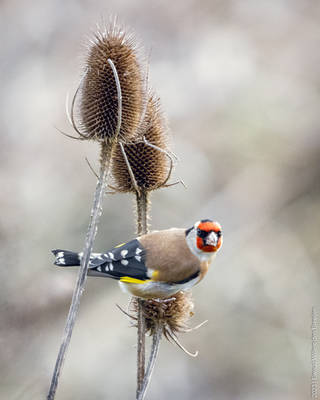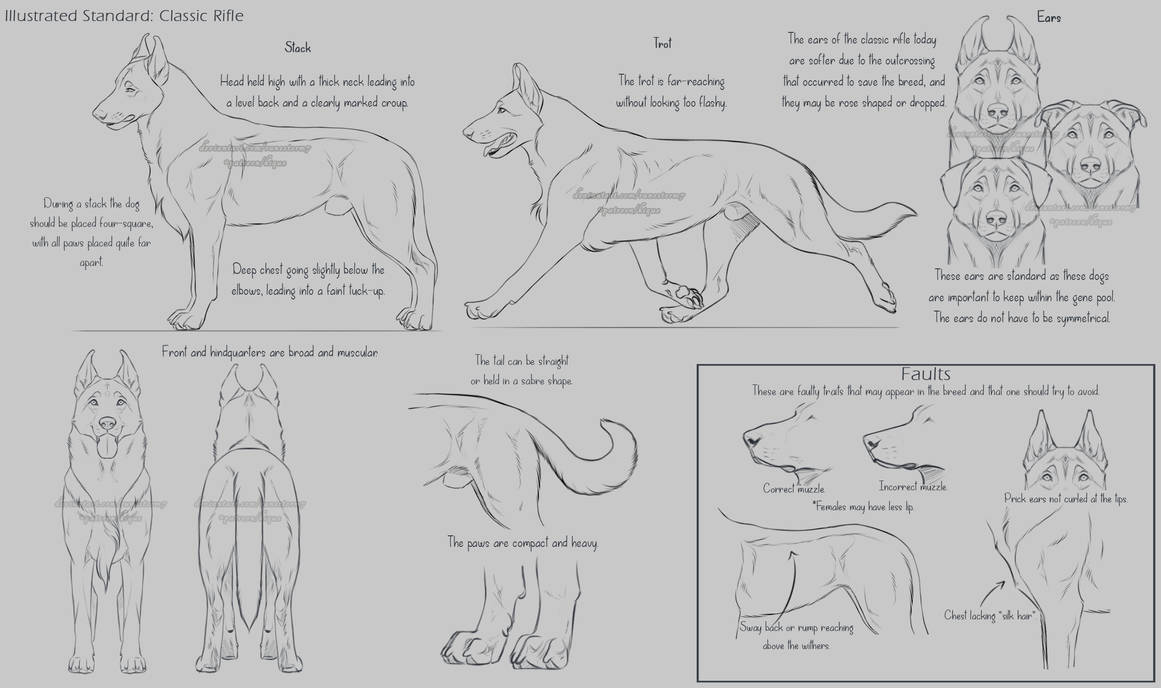ShopDreamUp AI ArtDreamUp
Deviation Actions
Breeds used: Rifle dog, beauceron & east-european shepherd
Common use: Protection, livestock guardian
Groups: FCI- Group 2 Cattledog, AKC- Working, UKC- Guardian, KC- Working
FCI Champion requirement: 2 CACIBs and 1 CACIT
Background
The classic rifle is a breed that was created around early 1800's to serve as a livestock guardian and hunter. The dogs could be found roaming the large farms, confident and independent.
Two branches later evolved from the classic, the northern rifle and rifle royale by mixing in german shepherd and dobermann. The classic rifle didn't do as well in modern times and the numbers of them dwindled to the point of the breed being more or less extinct, though efforts to recreate the breed has been made and the breed is making a comeback.
To recreate the breed beauceron and east european shepherd was brought into the old stock. Due to the dropped ears of the beauceron the ears of the classic has softened, causing dropped and rose ears to occur within the breed. But the soft ears are now considered standard to avoid cutting off too much valuable breeding stock.
Groups: FCI- Group 2 Cattledog, AKC- Working, UKC- Guardian, KC- Working
FCI Champion requirement: 2 CACIBs and 1 CACIT
Background
The classic rifle is a breed that was created around early 1800's to serve as a livestock guardian and hunter. The dogs could be found roaming the large farms, confident and independent.
Two branches later evolved from the classic, the northern rifle and rifle royale by mixing in german shepherd and dobermann. The classic rifle didn't do as well in modern times and the numbers of them dwindled to the point of the breed being more or less extinct, though efforts to recreate the breed has been made and the breed is making a comeback.
To recreate the breed beauceron and east european shepherd was brought into the old stock. Due to the dropped ears of the beauceron the ears of the classic has softened, causing dropped and rose ears to occur within the breed. But the soft ears are now considered standard to avoid cutting off too much valuable breeding stock.
The breed is in FCI Group 2 (cattledogs) as their nature is less that of a "living fence" type dog, and more of a livestock guardian.
General Appereance
Large and powerful with the body appearing square and moderate.
Males should have greater mass and be of a larger size compared to females.
Important Proportions
The length of the withers to the rump should be greater than the length of the withers to the ground.
Behaviour/Temperament
Independent but loyal, the dog will form a strong bond to its family and it may take some time for it to warm up to strangers. However, the dog should never show signs of aggression.
In general the classic rifle is affectionate and playful, with an eagerness to learn and please.
Cranial Region
Head: Broad head that appears quite heavy but shouldn't have too much loose skin.
Skull: Flat with moderate space between the ears and eyes.
Stop: Moderately pronounced.
Skull: Flat with moderate space between the ears and eyes.
Stop: Moderately pronounced.
Facial Region
Muzzle: Long, roman shaped nose, blocky muzzle with quite heavy flews. Females should have less lip. Nose can be any color.
Jaws/teeth: Strongly formed and powerful, scissor bite.
Eyes: Quite small with a friendly expression. Brown, amber, hazel or blue.
Muzzle: Long, roman shaped nose, blocky muzzle with quite heavy flews. Females should have less lip. Nose can be any color.
Jaws/teeth: Strongly formed and powerful, scissor bite.
Eyes: Quite small with a friendly expression. Brown, amber, hazel or blue.
Ears: Prick, rose or dropped. Dropped ears shouldn't be too heavy, be moderately sized and lay quite far back on the head. Ears with stronger cartilage may raise up to become prick as the dog gets older, and will naturally curl inwards at the tips, the stronger the cartilage the stronger the curled shape will be. A dog may have one ear dropped and one standing.
Neck: Broad with lots of mass to it, but not too much loose skin.
Body
Topline: Level with a clearly sloping croup.
Chest: Deep, reaching slightly below the elbows.
Underline and belly: Square body with a slightly visible tuck-up.
Paws: Short and tight, blocky appearance.
Topline: Level with a clearly sloping croup.
Chest: Deep, reaching slightly below the elbows.
Underline and belly: Square body with a slightly visible tuck-up.
Paws: Short and tight, blocky appearance.
Tail: Reaching the hocks, and may be straight or slightly curved, carried in a gentle sabre shape.
Stack: Placed four-square with broad distance between all paws.
Movement
Far-reaching without looking strenuous, and quite heavy without appearing lazy.
Hocks and pasterns should be firm and strong. Too much angulation in either is a fault.
Hocks and pasterns should be firm and strong. Too much angulation in either is a fault.
Coat
Double coat with longer fur present along the throat and chest, called "silk".
The coat is very thick and compact, and the tail shouldn't look too bushy.
The coat is very thick and compact, and the tail shouldn't look too bushy.
Color
All real dog genetics allowed. Fictional genetics link
Eyes: Brown, amber, hazel or blue. Any mixture of these is allowed.
Nose: Any color is allowed (black, blue, liver, isabella, and pink spotting)
Nose: Any color is allowed (black, blue, liver, isabella, and pink spotting)
Most common bases: Black, outlaw, wasteland, bay, sand, agouti, saddle, points
Most common markings: Palouse, mask, rawhide, merle, bronco, wrangler
Most common markings: Palouse, mask, rawhide, merle, bronco, wrangler
Size
Males: 67-72 cm / 26.3-28.3 in (85-105lbs)
Females: 62-67 cm / 24.4-26.3 in (75-95lbs)
Females: 62-67 cm / 24.4-26.3 in (75-95lbs)
Faults
Lacking longer fur on the throat/chest, called "silk".
Sway back or the rump raised above the withers.
Cow or sickle hocks.
Weak pasterns.
Shyness.
Health:

Cow or sickle hocks.
Weak pasterns.
Shyness.
Prick ears not curled at the tips.
Disqualifying faults
Docked or bobbed tail
Cropped ears
Double merle / Double harlequin
("MaM" Atypical merles are not to be considered unhealthy double merles due to one of the alleles being short. But these dogs should -not- be bred to other M dogs.)
Albino
Aggression
Aggression
Health:
Isengard breeds- Breed specific diseasesUpdated March 2024- DM test added to Kingshall, Akiulfr and Liulfr. vWd test added to Great Vildmarkens.
- - - - -Akiulfr - - - -
---- Body Scores
· Hips
· Elbows
· Patellas
· Eyes
---- Genetic Tests
· Progressive Retinal Atrophy, Progressive Rod-Cone Degeneration
· Degenerative Myelopathy
- - - - - Great Vildmarkens - - - - -
---- Body Scores
· Hips
· Elbows
· Patellas
· Eyes
---- Genetic Tests
· HUU Hyperuricosuria,
· PRA-PRCD, PRCD Progressive Retinal Atrophy, Progressive Rod-Cone Degeneration, SCID Severe Combined Immunodeficiency Disease (terrier)
- - - - King's Hall Hound - - - - -
---- Body Scores
· Hips
· Elbows
· Patellas
· Eyes
---- Genetic Tests
· PRA-PRCD, PRCD Progressive Retinal Atrophy, Progressive Rod-Cone Degeneration
Ichthyosis
· Degenerative Myelopathy
- - - - - Liulfr- - - -
---- Body Scores
· Hips
· Elbows
· Patellas
· Eye
Standard: Great Vildy
Revised 15th Apr 2024
Country of origin: Sweden
Breeds used: Vildmarkens Terrier & Taiga Gazal
Common use: Hunting-Bird, fox and hare
Groups: FCI- Group 7, AKC- Sporting, UKC- Gundog, KC- Gundog
FCI Champion requirement: 2 CACIBs and 1 CACIT
Impression
A medium-sized, athletic dog that has an alert but friendly expression.
Behaviour
Bold, friendly and playful.
The terrier blood in them may make them a challenge to raise, but with patience comes great reward. A well trained Great Vildy is a lovely companion, ready for anything and with its goofy nature brings a smile to your face daily.
Head
Long, broad head with a defined stop.
CACIT Hunting Event- Snowcap Burrows Closed
:new: Results! https://sta.sh/01fxqbnyuw0p
To kick off the new hunting trials, Isengard-Breeds is hosting a CACIT event where the prey is the quick and attentive European Rabbit at Snowcap Burrows.
The scenery is as shown on the banner; A golden red field with medium tall grass, leafy trees and a thick fog spread across the plains.
The hunt will take place early in the morning, so the grass will still be wet with dew.
The dog's task is to flush the rabbits out of their hiding, and chase them towards the hunter.
All participating dogs will be one step closer to completing their Novice Hunter class, earn a mount for participating, and a trophy
Isengard Breed Genetics- Updated and revamped
Update 30th Oct 2019
New marking guides: I'm currently working on getting new and more detailed guides on how the genes work and look.
The markings that has been completed are highlighted in blue. Click on the headshots to get the link to the guide. https://home-comic.wixsite.com/homewikia/genetics
-----------------------------
Link to old journal- https://sta.sh/01bhzjlhlb7b
:new: This journal will no longer be updated as this wiki will be used for all fictional genes instead:
Genetics
Isengard breeds- Breed specific diseases
Updated March 2024- DM test added to Kingshall, Akiulfr and Liulfr. vWd test added to Great Vildy.
- - - - -Akiulfr - - - -
---- Body Scores
· Hips
· Elbows
· Patellas
· Eyes
---- Genetic Tests
· Progressive Retinal Atrophy, Progressive Rod-Cone Degeneration
· Degenerative Myelopathy
- - - - - Great Vildy - - - - -
---- Body Scores
· Hips
· Elbows
· Patellas
· Eyes
---- Genetic Tests
· HUU Hyperuricosuria
· PRA-PRCD, Progressive Retinal Atrophy, Progressive Rod-Cone Degeneration
· Von Willebrand Disease I
- - - - King's Hall Hound - - - - -
---- Body Scores
· Hips
Featured in Groups
© 2014 - 2024 Isengard-breeds
Comments1
Join the community to add your comment. Already a deviant? Log In


